This website is supported by its readers. If you click one of my links I may earn a commission. I am also a participant in the Amazon affiliates program and I will also earn a commission from qualified purchases.
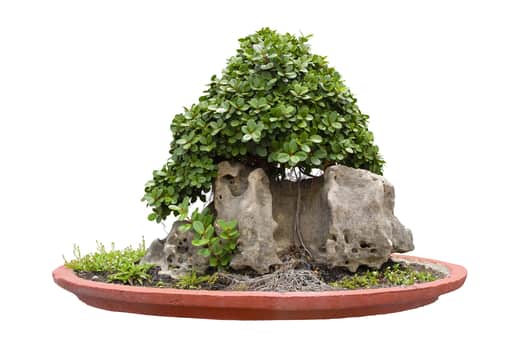
When someone new to bonsai asks me what the best tree for a beginner is, without a doubt the tree species that comes to mind is Ginseng Ficus Bonsai Trees. These trees can be grown both indoors and outdoors, can sometimes produce fruit, and are very hard to kill. So how exactly do you care for a Ginseng Ficus bonsai?
Water ginseng ficus once per day. Only water when the topsoil is dry. Ensure ficus bonsai has 4 hours of direct sunlight. Place either outdoors or indoors. Fertilize twice per month during the spring and summer. Do not keep at temperatures below 60 degrees F or higher than 100 degrees F.
Now, this information is truncated so how exactly do you care for a ginseng ficus bonsai? How do you grow a ginseng bonsai from scratch or repot a ginseng bonsai? Keep reading to find out more!
Just a quick heads up, over the past three years of running Plantpaladin, hundreds of people have asked for product recommendations. As such, You can find my favorite indoor bonsai tree here (link takes you to Bonsaiboy), my favorite outdoor bonsai tree (link takes you to Bonsaiboy), or have a look at all the products I recommend here.
Ginseng ficus bonsai trees
Ficus bonsai (also known as fig tree bonsai) is easily one of the most popular bonsai tree species out there.
As such, there is a lot of information from reputable websites on how to care for these species.
Sadly, however, there can often be too much information, leaving you, the owner of your brand new Ginseng Ficus bonsai trees, more confused than your first started.
As such, I got in touch with a few bonsai experts, visited my local botanical gardens, have kept a few ficus bonsai, and even did a survey of 20 plant paladin readers, asking them on the best way to grow, maintain, and generally care for ginseng ficus bonsai trees.
This then provides you with the most in-depth article out there on keeping ginseng ficus bonsai tree!.
To summarize:
Ginseng Ficus bonsai trees quick facts
Ginseng Ficus Bonsai tree Requirements | Explained |
Water | Once per day in the spring-summer or if kept indoors. Once per week if kept outdoors during the winter. Only water if dry to touch. |
Sunlight | 4 hours of direct sunlight in the summer. LED grow light can also be used. |
Temperature | Between 60 degrees F and 100 degrees F |
Fertilizer | Fertilize 18 times per year, twice per month between spring and summer. Once per month in the fall and winter |
Repotting | Once every 2 to 3 years in the first 10 years. You can then report once every 5 years |
Placement | Can be placed outdoors in direct sunlight or indoors in a bright spot. |
Wire type | Both copper and aluminum wire can be used. |
Time to grow from scratch into maturity | 8 to 12 years to reach full maturity |
Potting soil | An inorganic Akdama, volcanic ash soil mix works best. |
Growth type | Slow growing, averaging 3-5 inches per year |
Size | Average store-bought trees are size is one or two-handed bonsai trees - 3 to 10 inches in size, 2 to 8 inches wide |
Lifespan | 50 to 150 years |
Fruit | figs |
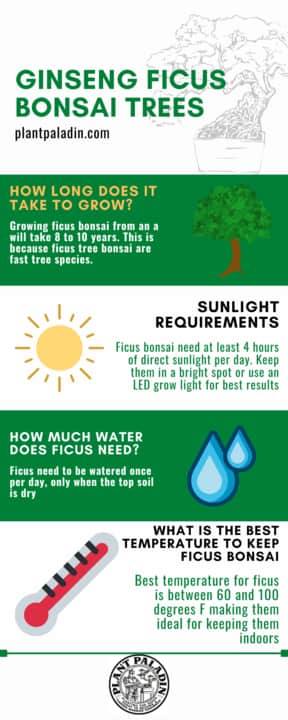
Let’s explore these in more detail:
How often should I water my ginseng ficus bonsai?
Ginseng ficus bonsai trees should be watered at least once per day during the spring and summer. Only water if the topsoil is dry to touch and never water when the topsoil is wet as this can cause overwatering. If ginseng ficus is kept outdoors, water once per week in the winter.
Using regular tap water can work well, however doing this for prolonged periods will change the ginseng ficus bonsai trees’ soil PH level.
A good alternative would be to use something like a water filter or better yet, collect rainwater from outdoors in a bottle or bucket and use that to water.
Overwatering a Ginseng ficus bonsai can result in a lot of molds or fungal infection so only water if the topsoil is dry.
If the topsoil is moist, wait another day.
Now in the summer, you might need to water more often, so if you have watered your ginseng ficus bonsai trees in the morning and by the afternoon the topsoil is dry to touch, then definitely water again.
Misting can also be undertaken if you are worried about overwatering your ficus bonsai.
What should I water my ginseng ficus bonsai with
Realistically you can water your ficus bonsai with anything – a jug, watering can, hose pipe spritzer can, or another device.
That being said, some top tips for watering your ginseng ficus would be the following:
- Make sure you check the base of your bonsai pot 30 minutes after watering to ensure your ficus is not pooling water – this can cause root rot.
- Ficus bonsai are very forgiving, this means you can skip the odd watering on a ficus bonsai – Do not let this develop into a habit, however, and ensure someone waters your bonsai should you go on vacation.
- Moisture trays can help if you live in a dry environment to give a consistent flow of water
- A good amount of water for a small to medium-sized ginseng ficus bonsai would be about 1/3rd a cup of water – aim for this to flow through the tree and pour directly on the topsoil for best results.
Sunlight requirements for Ginseng Ficus Bonsai
Aim for your ginseng ficus bonsai trees to get at least 4 hours of direct sunlight per day in the summer. LED grow lights can also be used if ginseng ficus bonsai is kept indoors. Aim to move the bonsai indoors during cold winters.
Whilst all bonsai trees require full direct sunlight during the year to function, one of the reasons why ficus bonsai is so beginner-friendly is that it only really required 4 hours of direct sunlight in the summer – making them ideal for keeping indoors and the perfect gift idea.
To give you an idea, other trees such as Chinese elm, jade, scots pine, olive oak, or juniper can require as much as 8 hours.
As a result of this, these trees can be easily grown indoors with LED grow lights. Aim to keep these about 10 inches away from your tree and ensure you use a light that contains both red and blue light to ensure your ginseng ficus bonsai trees get the full spectrum of light.
What is the perfect temperature for ginseng ficus bonsai?
Ginseng ficus bonsai should be kept between 60 degrees Fahrenheit (15 degrees Celsius) and 100 degrees Fahrenheit (37 degrees Celsius). Ginseng ficus does not thrive in colder conditions and should be kept indoors if temperatures fall below this.
Due to these temperature requirements, ginseng ficus is one of those rare types of bonsai species that will thrive indoors for most owners.
If you are adamant about keeping your bonsai outdoors and live in the USA, ensure that you live in USDA hardiness zones that fall into the 12b, 13a, and 13b categories.
What countries have the perfect temperature for ginseng ficus bonsai trees?
Now I get readers from around the world so I’ve put together a list of countries/regions that you can keep ginseng ficus outdoors in:
- Australia
- South Asia
- The Mediterranian
- The middle east
- Africa
Countries where you should keep ginseng ficus indoors include:
- The UK
- Russia
- Western, eastern, and northern Europe
- East Asia
- The USA – unless you live in a locale with year-round sun
- Most of South America in the fall and winter
In most of these locations, however, ginseng ficus can be kept outdoors during the spring and summer when temperatures pick up.
Fertilizer requirements for ginseng ficus bonsai
Ginseng ficus bonsai should be fertilized twice per month during the spring and summer months, between March and August. Ficus bonsai can then be fertilized once per month during the fall and winter if growth continues. Both liquid fertilizer and organic pellets can be used.
What fertilizer should you use for ginseng ficus bonsai?
Any good fertilizer for ginseng bonsai required 3 main elements:
- Nitrogen
- Phosphorous
- Potassium
Finding a fertilizer that has a good mix of all three would be ideal – I like to look for balanced fertilizers that have a ratio of 10:10:10 – this is better known as the NPK ratio on the back of most fertilizer packs.
What about liquid fertilizer?
Liquid fertilizer can also be used for ginseng ficus bonsai trees.
If you are tight on time, then to save yourself a lot of trouble I’d consider using liquid fertilizer.
Aim to use a liquid fertilizer that also contains a balanced mix of the above elements, but also one that you can pour easily into the cap of the fertilizer cap – making measurements easy.
Liquid fertilizer has a bunch of other benefits such as having built-in pesticides, being easier to be absorbed directly into leaves and roots.
They are also often concentrated making for much stronger, faster growth for ficus bonsai.
When should you repot ginseng ficus bonsai?
Ginseng ficus bonsai should be repotted once every two to three years. As ginseng ficus trees are fast-growing, they can add 12-36 inches of size in one year. This means the roots will soon outgrow the pot that they are in.
Failure to report a bonsai will limit its ability to absorb nutrients in the potting soil, causing it to become weaker and more susceptible to infections and disease.
How to repot ginseng ficus bonsai?
If you are new to bonsai keeping, you are probably asking yourself how the hell do I repot my ginseng ficus bonsai trees.
Well fear not, I’ve written an entire post on repotting bonsai here. As you can imagine it’s a topic all unto itself.
That being said I’ve summarised below:
Ensure it’s the right time of year
Before you start repotting your Ficus, make sure it’s the right time of year.
Bonsai trees get weaker later in the year and won’t have enough time to manage the intense repotting process.
Aim then to do this as early in the spring as possible.
I like to do mine in the first few weeks of March.
Remove your ginseng ficus from its existing pot
Use a root hook to go around the edges of your pot.
This will loosen up the soil around the ficus making it easier to remove.
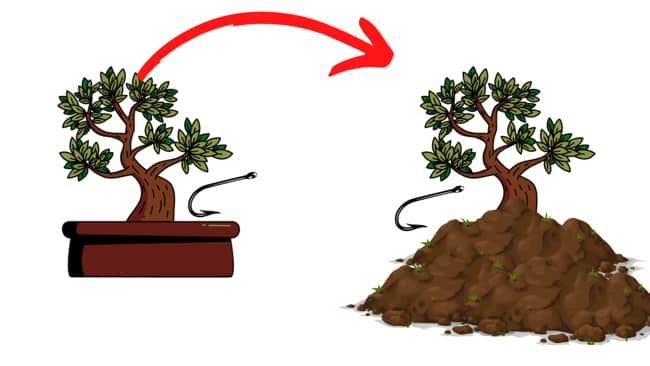
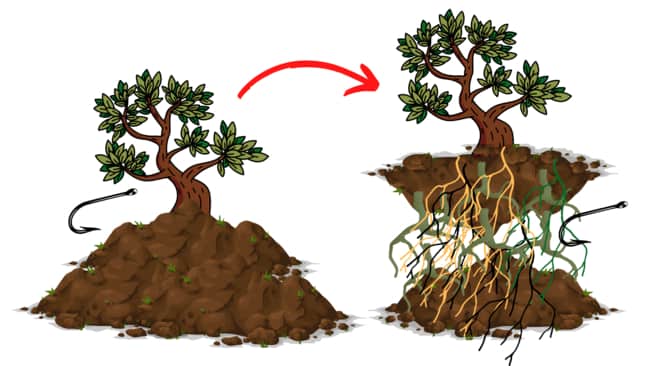
Remove any excess roots
Now your ficus has been removed, there will be a lot of excess roots that need to be trimmed down. Use a sharp pair of scissors to trim these down to size.
Feeder roots can also be trimmed down
Do not remove all the roots, however, as these will be vital to your tree’s survival.
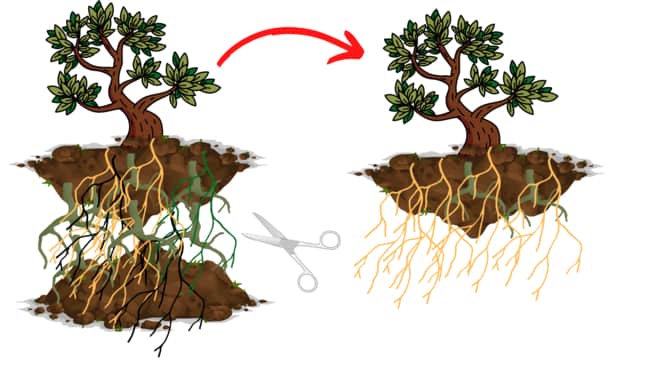
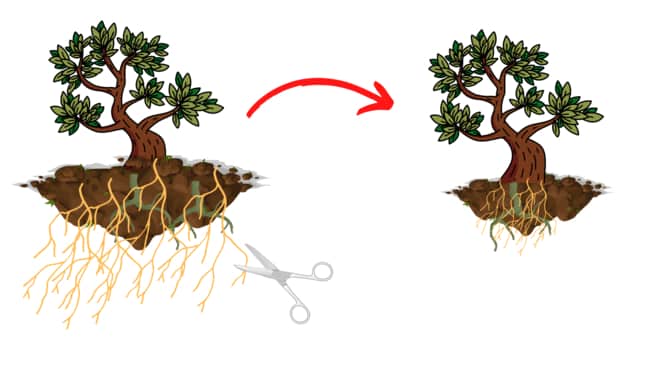
Gather and prepare your new pot
Now your ficus bonsai is ready to be removed it’s time to get your pot ready.
First, ensure your new bonsai pot has enough drainage holes.
The table below should help summarize how many holes you will need for the size of your tree.
Size Classification | Size inches | Number of penny-sized holes | Number of pencil-sized holes |
Keshitsubo | 1 to 3 inches | 1-2 | 0 |
Shito | 2 to 4 inches | 1-2 | 0 |
Mame | 2 to 6 inches | 2 | 2 |
Chohin | 5 to 8 inches | 2 | 2 |
Kumono | 6 to 10 inches | 2 | 2 |
Katade-mochi | 10 to 18 inches | 2 | 3 |
Chiu or Chumono | 16 to 36 inches | 2 | 4 |
Dai or Omono | 30 to 48 inches | 3 | 6 |
Hachi-uye | 40 to 60 inches | 4 | 8 |
Imperial | 60 to 80 inches | 6 | 8 |
Then add a mesh to the holes.
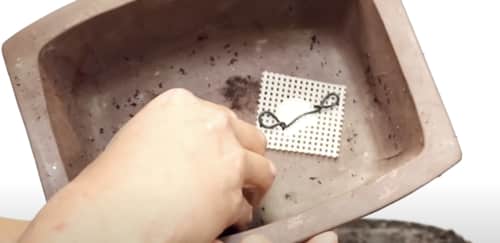
This will help hold your tree in place but also prevent water from overflowing onto your surfaces.
This wire mesh will also ensure your tree gets enough moisture but not too much moisture that the tree root begins to rot.
You can secure this with wire.
Finally, loop in copper wire in the range holes and mesh which will be used to hold your tree in position.
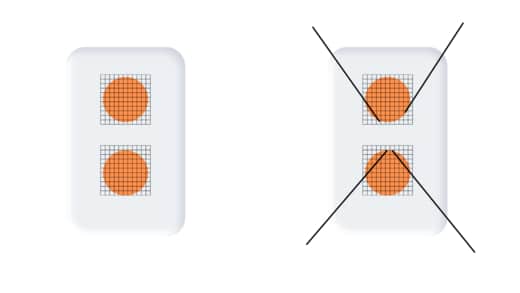
I find that two 15 inch strands of copper wire tend to work for most small to medium-sized ginseng ficus bonsai trees.
Add a base layer of potting soil
We will talk about the exact makeup of the soil you need for ginseng ficus bonsai in this post later, but for now, the next step will require you to add a bottom base layer of potting soil.
Aim for this to cover the bottom one to two CM of your new pot.
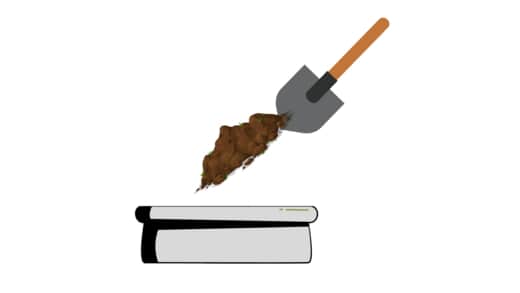
Plant your bonsai
Finally, finish up by planting your bonsai tree.
Simply place it on the topsoil and wrap the copper wire around the trunk of the tree – this will prevent it from moving.
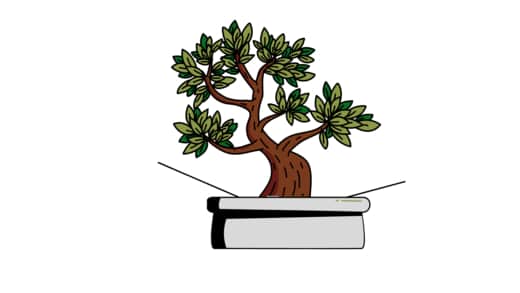
Add the remainder of the potting soil until the roots are completely covered.
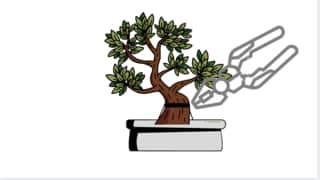
You can then use a chopstick or the end of a spoon to plug up any air holes in the soil that can cause your ficus roots to dry out.
Ensure once the process has been completed, adequate bonsai repotting aftercare is provided.
Where to place ginseng ficus bonsai trees?
Ginseng ficus bonsai should be kept indoors in colder milder climates and outdoor in warmer Mediterranean climates. Aim to place ginseng ficus in a bright spot with plenty of direct sunlight such as near a window for best results.
As mentioned earlier, most of you reading this, will not be living in climates that allow you to grow ficus bonsai outdoors year-round.
As such, finding a good location indoors where plenty of light will be ideal.
I find spaces with a lot of windows so that the tree can get its 4 allocated hours of sunlight work best.
As such, kitchens or better yet, open-plan kitchens that have large windows or access to gardens work best.
I would avoid keeping ginseng ficus in a garage, cupboard, or space where there are no windows.
On top of this, you also want to look for a room indoors that does not fluctuate massively in temperatures day in day out.
For example, keeping a ficus in a bathroom might not be ideal due to the amount of moisture.
If you have excessive heating in the winter and have a lot of air conditions in the summer this might impact the health of the tree.
What if I want to keep my Ginseng Ficus outdoors?
If you are lucky enough to live in a climate where you can keep your ginseng ficus outdoors year-round, I would consider leaving the tree in the brightest spot in your garden for 4 hours per day during the spring and summer.
The ficus bonsai can then be moved into the shade to prevent it from burning or drying out.
If you are afraid that you have nowhere to place your bonsai, consider investing in a purpose-built bonsai greenhouse that will allow you to manage all aspects of temperature.
What wire should I use on my ficus bonsai?
Both copper and aluminum wire can be used on ginseng ficus bonsai when training the tree. This is because the branches are strong and can handle the excess pressure that aluminum wire can have on its branches.
While copper and aluminum wire both work well, I would avoid using other types of wire made of other materials such as plastics or stronger materials such as steel as this can damage the tree.
Jute rope, yarn, and other materials can also be used to wire your ginseng ficus bonsai should you want to avoid metal wires altogether. To read up more on this check out my post here.
How to wire a ginseng ficus bonsai?
So we touched upon what the best wire to use for ficus bonsai is, but we haven’t gone into how to train the branches of your tree using wire.
As you can imagine this is a large process in itself, which is why I’ve written a post on the topic here in a lot more detail.
That being said I’ve summarised it below briefly:
Design how you want your ficus to look
Doing so will allow you to get a good idea of the direction you need to move the branches of your tree in.
This will make the process of wiring your ficus a lot easier without you having to think on the spot if you are wiring the branches correctly.
Cut your wire to size
Aim for the wire to be about 1/3rd the size of the thickness of the branch you will be wiring it against.

To test if the wire you have cut is strong enough to be used on the branch, you can push it against the branch.
If the branch pushes the wire more than the wire pushes the branch then opt for a thicker grade wire.

You also want to aim that the wire you cut is also about 30% longer than the length of the branch – this is to ensure you can wrap it around the trunk of the tree too.
Wrap the wire around the trunk of the tree
Next up, wrap the wire around the trunk of your ficus.
This should wrap about 2 to three times on your ficus bonsai trunk.
This will be the anchor point for the wire and make it easier to bend the branches later.
Aim then, to wrap the wire at a 45-degree angle.

Double and signal wire your branches
It is now time to wire your branches.
This falls into two main categories; double wiring and single wring.
Single-wiring is the most common type of wiring – you will simply use one wire to wrap one branch at a 45-degree angle.


This method is also used for the smaller secondary and tertiary branches with smaller wires.

Double wiring is undertaken on two branches that are nearby each other.


Double wiring can be more effective at leveraging other branches to move heavier, sturdier branches.
Move the branches into position
Once your tree has been completely wired, use your thumb and index finger to bend the branches into their new positions.
Most branches move in either clockwise or anticlockwise positions so use this to make moving these branches easier.
Remove the wires
After 5 to 8 weeks the wiring process should be completed and the branches will have settled into their new position.
You can then cut the wire.
If one of the branches is too big or strong to be moved using traditional wiring techniques, consider using a guy wire to help hold thicker branches down into position.
How long does it take to grow a ficus bonsai from seedling?
Ginseng ficus bonsai are fast-growing trees and can reach maturity in 8 to 12 years, with most taking 10 years to reach full maturity. This process can be sped up by keeping the tree indoors and using grow light to mimic spring and summer conditions when the tree grows the fastest.
How to grow a ginseng ficus bonsai from scratch?
Like wiring, growing ginseng ficus bonsai trees from scratch is a very complicated process that I have done justice to on this post here.
To summarize, however:
Select the right potting soil
We will touch on the best potting soil later in the post, but for now, ensuring the soil you choose has a good mic of moisture retention, moisture flow and aeration will prevent your tree from trying out.
A good mix for ficus bonsai would be an inorganic Akadama, volcanic ash rock mix.
Decide if you want to use cuttings or seeds
If you are using seeds to grow your ficus, simply put them in the potting soil, cover them with more topsoil and move on to the next step.
If however, you are using a cutting, you need to treat these.
Start by removing any excess leaves from the cutting.
Then score a 1mm circle around the bottom of the cutting.

Peel this back until the white inner wood of the cutting is exposed.
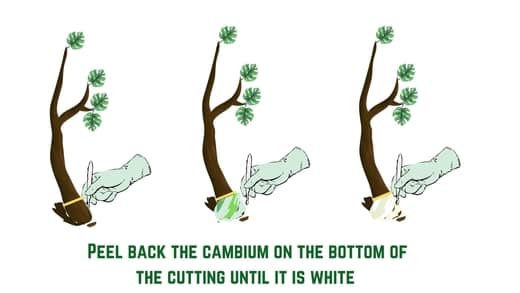
Then apply root hormone to the cutting
Select the right pot
Similar to repotting, use a small growing pot for the first few months of growing your tree – I like to use yogurt pots as they are a perfect size.
I’d strongly suggest using smaller yogurt pots for ficus seeds and larger yogurt pots for ficus cuttings.
Ensure again however that these have enough holes at the bottom.
Plant your seed or cutting
Next up simply plant your seed or cutting.
If using seeds, simply cover twitch the remaining topsoil and move on to the next step.
If using a larger cutting, you may want to secure this in the pot with copper wire before moving on to the next step.
Keep in a propagator
As your seeds/cutting for the ficus will have just been planted they are their most delicate stage.
I would stronger recommend then keeping them in a propagator for the first 6 weeks where you can carefully control their moisture levels, sunlight, and temperature requirements.
Ease them into the new location
After 5 weeks, the seeds and cutting should have sprouted and they can be moved into a new location. Move them into one of the bright sunny conditions we mentioned earlier on.
Train your ginseng ficus bonsai
After a year or so I would recommend repotting your ficus as it will be strong enough to thrive in a new pot.
A few months after repotting, you might be wondering why your ficus does not look like a bonsai tree.
This is because, over the next few years, you will need to train your tree.
This is done in a few main ways:
- Through bonsai trunk development – Where you will grow out sacrifice branches, chop the top of your bonsai trunk and bend the trunk of your bonsai to add girth, movement, and taper to your ficus trunk
- Wiring your bonsai – As talked about previously, this will help develop the branches of your tree and move them into the position you want them to go.
- Pruning your tree – This will increase the number of leaves on your tree through defoliation and will improve the ramification on your tree.
Further bonsai training can be undertaken such as developing Jin, nebari, or using lime sulfur to create deadwood.
All in all, the process of developing the ginseng ficus into a tree that resembles a bonsai will take around 10 years.
What is the best potting solid for ginseng ficus bonsai?
The best potting soil for ginseng ficus bonsai would be an inorganic mix of 30% akadama,30% volcanic ash rock, and 30% perlite. Ensure the soil PH temperature falls between 6.6 to 7.5 for best results.
Whilst the above is the ideal potting soil mix for ginseng ficus, any inorganic bonsai soil mix will work best for ficus bonsai so long as it provides good aeration, moisture retention, and moisture flow.
Even some organic soil mixes such as soil mixes with peat moss can work well. I’ve also used cactus soil in the past which too can work well for most bonsai.
How fast-growing are ginseng ficus bonsai trees?
Ginseng ficus bonsai trees are incredibly fast-growing bonsai, averaging between 12 to 26 inches of growth per year. Due to this growth, they need to be repotted more frequently, once every 2 to 3 years.
To compare how fast-growing ficus is compared to other popular bonsai species, check out the table below:
Bonsai species | Growth type | Time to maturity | Average growth per year |
Chinese Elm | Fast | 3 years | 12 to 36 inches |
Juniper | Moderate | 4 years | 5 to 12 inches |
Jade | Slow | 5 years | 2 to 5 inches |
Maple | Fast | 3 years | 12 to 36 inches |
Fukien Tea | Slow | 5 years | 2 to 5 inches |
Ficus | Fast | 3 years | 12 to 36 inches |
Wisteria | Slow | 5 years | 2 to 5 inches |
Cotoneaster | Moderate | 4 years | 5 to 12 inches |
Pine (most varieties) | Fast | 3 years | 12 to 36 inches |
Azalea | Slow | 5 years | 2 to 5 inches |
How long do ficus bonsai live?
Ficus bonsai is a long-living bonsai species and typical lives between 50 to 150 years on average., Ginseng ficus bonsai trees that are well cared for have been known to live as long as 400 to 600 years.
To read up more on how long bonsai trees live, and how older bonsai trees can cost more, I’d recommend reading my posts.
Does ginseng ficus bonsai produce fruit
Ginseng ficus bonsai also known as fig tree bonsai can produce figs if pollinated correctly. Ginseng Ficus, however, will only produce edible fruit in warmer hotter climates if kept outdoors meaning the chances of producing figs for most bonsai keepers will be limited.
Advanatges of ginseng ficus bonsai
The main advantages of ginseng ficus bonsai include:
- Very beginner-friendly – Overwatering, not getting enough sunlight, or forgetting to fertilize this tree will not be as severe as it would be for other species, making this the perfect bonsai for beginners.
- Can go without water – Not watering for a few days will not significantly damage this tree.
- Can be kept indoors – Unlike a lot of other bonsai, ficus bonsai are perfect at being kept indoors making them ideal if you live in a flat or apartment.
Disadvantages of ginseng ficus bonsai
- Fast-growing – Meaning you will have to repot this bonsai more frequently than other species.
- Can’t be grown outdoors – most outdoor climates are too cold for this tree meaning you will have to be content keeping these away from other bonsai in your collection.
What pests attack ginseng ficus bonsai
Ginseng ficus bonsai are typically resistant to insect infestation. In conditions of dry air and lack of light, however, this can weaken the tree. This makes ficus bonsai more susceptible to attacks from scale, spider mites, and aphids.
To remove, use liquid soap in a spray bottle or vinegar in cotton wool to neutralize.
Alternatively, check out my post here on removing pests from bonsai.
Is ginseng ficus bonsai beginner-friendly
Ginseng ficus bonsai is one of the best beginner-friendly bonsai tree species. Lack of watering, light, and fertilizer tolerance is a lot higher than other species. Ficus varieties are also naturally good at defending themselves against insect infestation making them easy to care for.
Study
Finally, I didn’t just want to give the information I learned when it came to keeping ginseng ficus bonsai but wanted to get the opinion of you, my readership.
As such I asked 10 plant paladin readers their thoughts on if ficus bonsai was an easy bonsai tree to keep – here were the results:
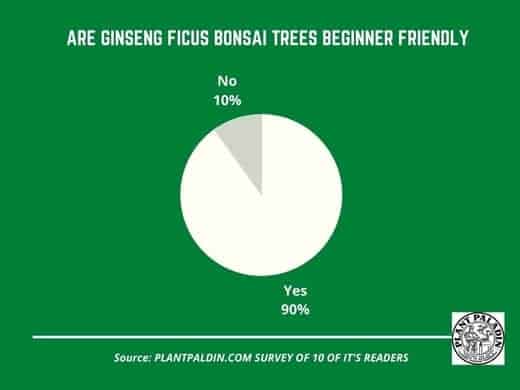
My top picks for the gear you will need!
So like I mentioned earlier, over the past three years of running PlantPaladin, hundreds of people have asked me for my recommendations on the best bonsai gear on the market.
Having spent thousands of dollars on bonsai items these past few years and tested at least 100 bonsai-specific products, I’ve listed my favorite products below – All of which I highly recommend and think you can get great value.
They can purchase directly by clicking the link to take them to Amazon.
Bonsai Tool Set: One of the significant challenges I’ve had is finding a toolset that was not only durable but didn’t break the bank. SOLIGT has recently developed a fantastic bonsai tool set that covers all the tools you need to trim, prune, and repot your trees. – You can grab it here.
Complete Bonsai Set: Many of you will want to grow your bonsai trees entirely from scratch, but finding the varicose seeds, pots, and other items in one place can be challenging. Leaves and Sole then have created a complete bonsai set that I’ve personally used that ticks all the boxes. You can grab it here.
Bonsai wire: The number of times I’ve run out of wire for my bonsai or purchased cheap bonsai wire that doesn’t do the job is embarrassing for me to admit. After a lot of trial and error, I found that using Hotop’s aluminum bonsai wire is one of the best options on the market. This can easily be used for both indoor and outdoor bonsai. You can grab it here.
This post was written by Fehed Nicass who has been passionate about bonsai for over 3 years.
